Lemon Pound Cake
This post may contain affiliate links. Read my full disclosure policy.
This lemon pound cake is the ultimate dessert for lemon lovers.
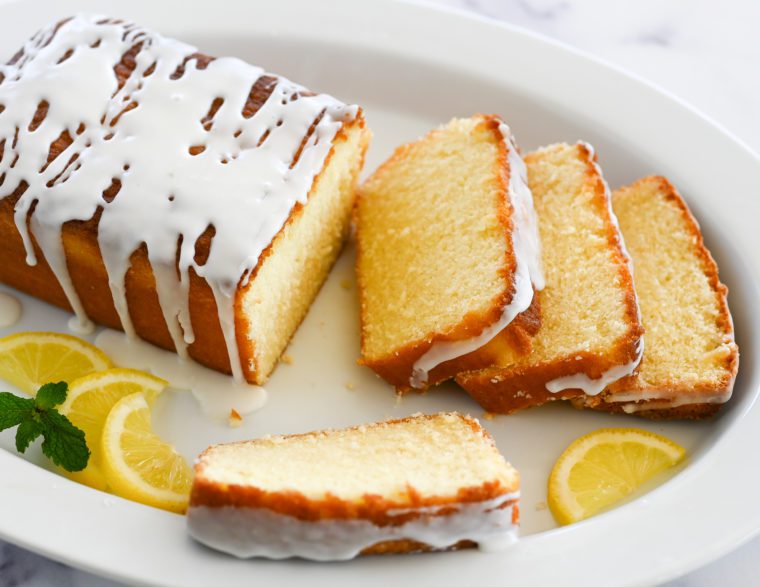
Calling all lemon lovers! This lemon pound cake is a dessert made just for you. The recipe incorporates both lemon zest and lemon juice into the cake batter, infusing the cake with a lovely lemon flavor. But the real magic happens after baking — the cake is generously doused with lemon syrup and then drizzled with a tart lemon glaze, delivering an intense burst of lemon flavor with every bite. The recipe yields two ultra-moist loaves that stay fresh for days on the countertop or can be frozen for later. If you’d like to switch things up, try my popular lemon poppyseed cake and lemon blueberry pound cake variations. A big thank you and shoutout to Karen Tannenbaum, one of my longtime readers, for inspiring this wonderful recipe!
What You’ll Need To Make Lemon Pound Cake
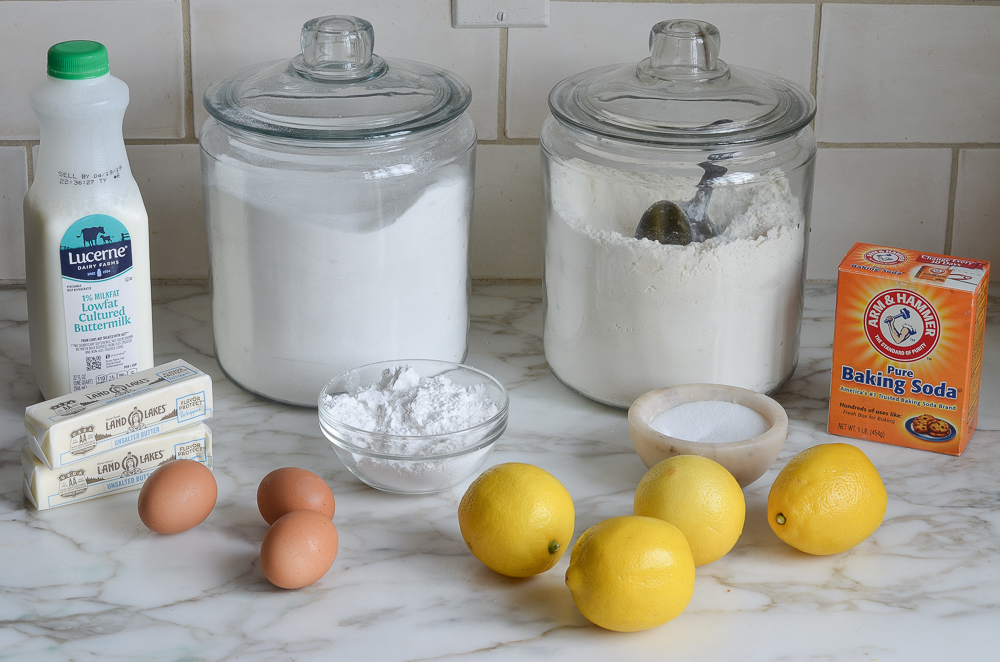
STEP-BY-STEP INSTRUCTIONS
Start by zesting and juicing your lemons. And be sure you zest the lemons first, otherwise, it will be impossible once they are juiced. The best tool for zesting is a rasp grater but any fine grater will do.
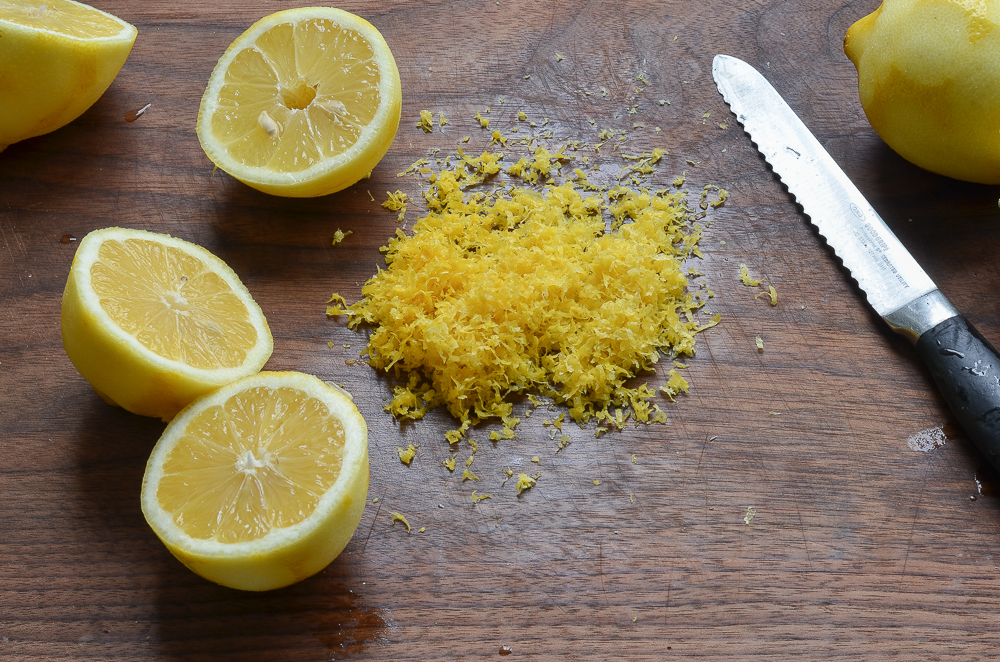 Combine the flour, salt, and baking soda in a mixing bowl. I always add dry ingredients in little piles so I don’t forget what I’ve already added.
Combine the flour, salt, and baking soda in a mixing bowl. I always add dry ingredients in little piles so I don’t forget what I’ve already added.
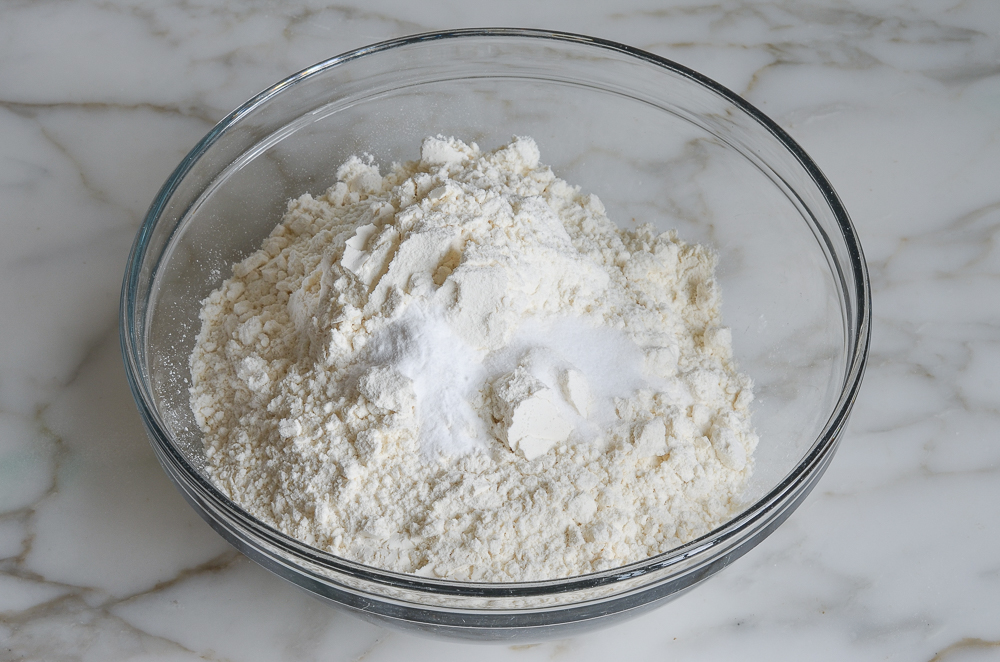 Whisk and set aside.
Whisk and set aside.
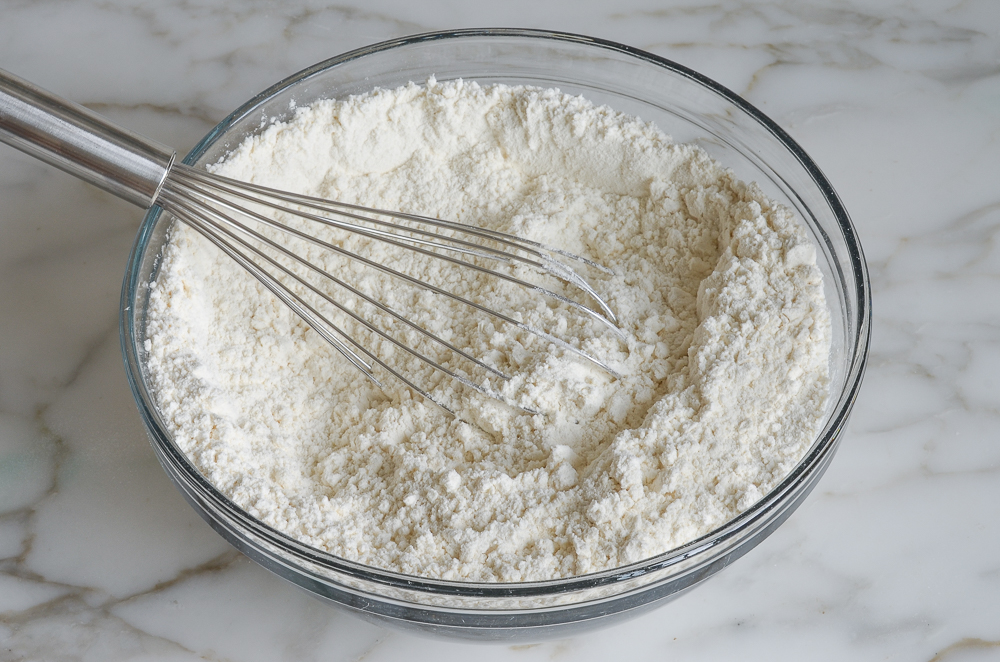
In another bowl, whisk together the buttermilk, lemon zest, and lemon juice. Set aside.
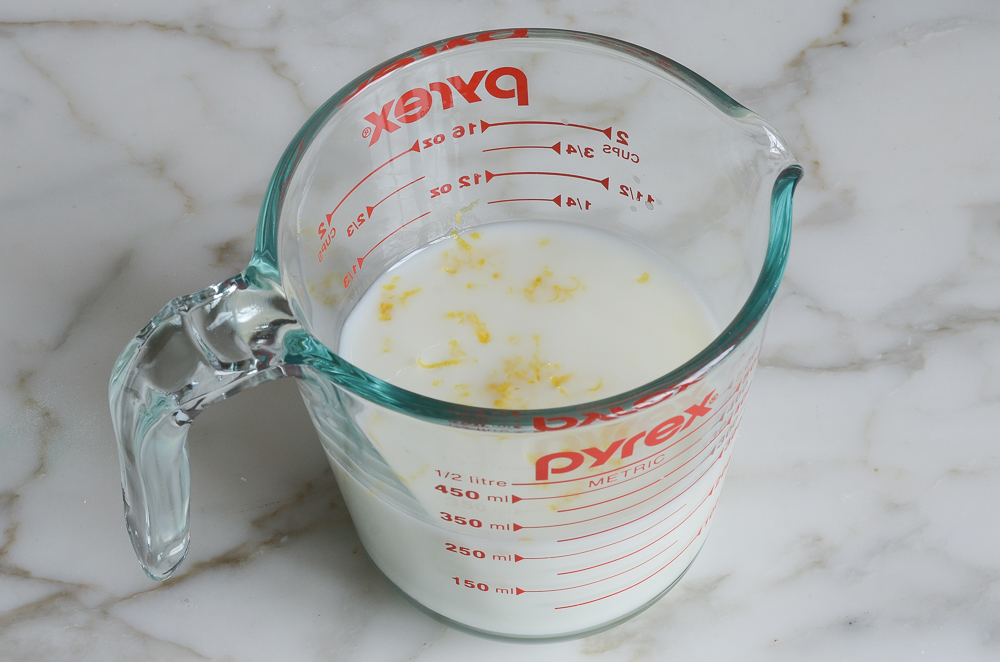
In the bowl of an electric mixer fitted with the paddle attachment (or beaters), cream the butter and sugar on medium speed until light and fluffy, 3 to 4 minutes.
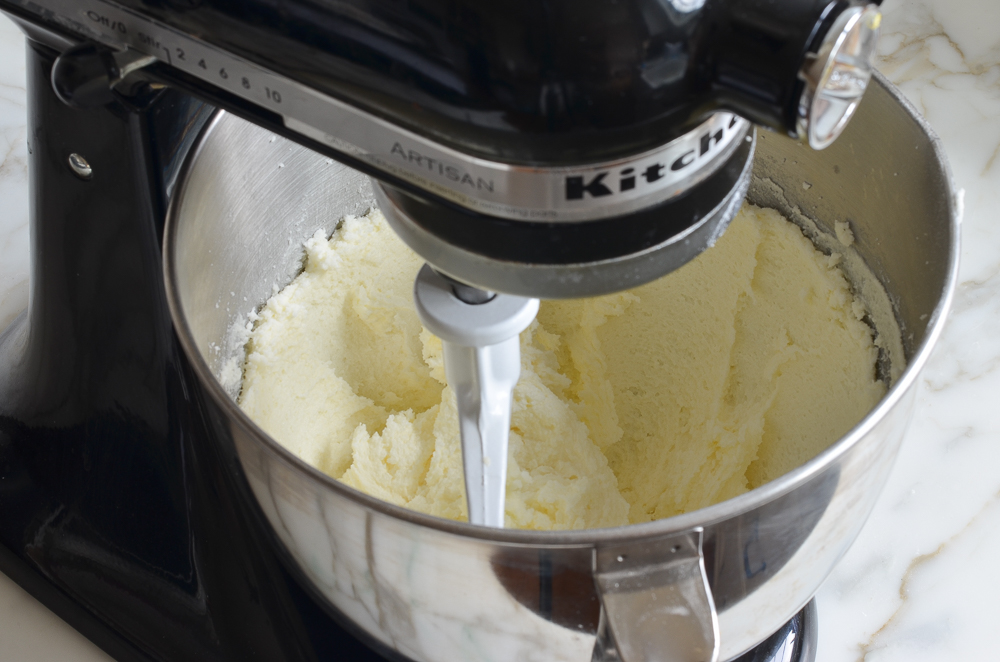
Scrape down the sides of the bowl, then beat in the eggs one at a time, beating well after each addition. Scrape down the sides of the bowl again.
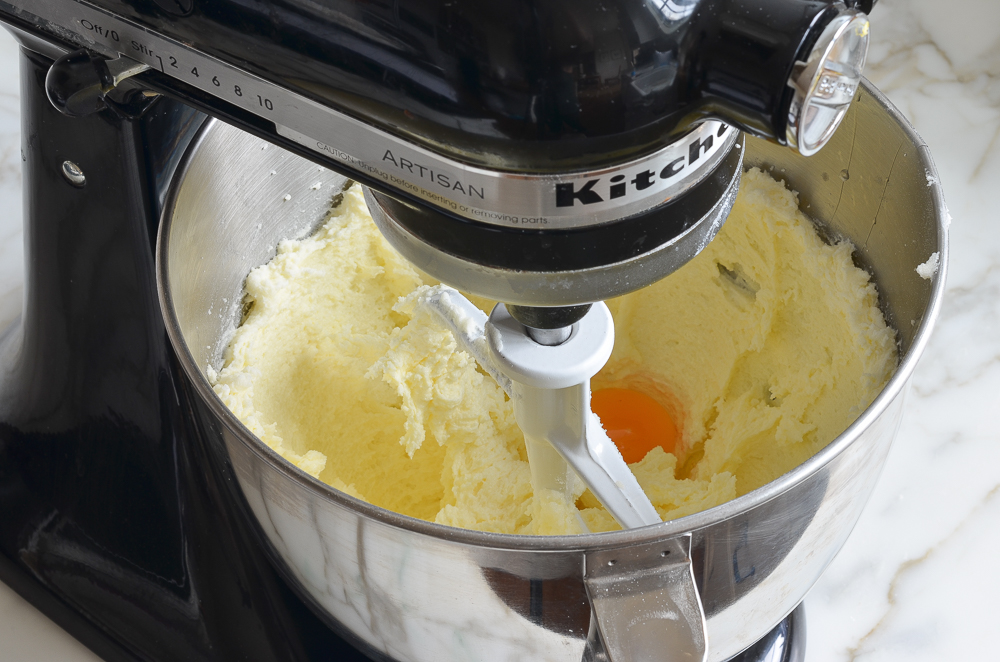
With the mixer on low speed, beat in one-quarter of the flour mixture, then one-third of the buttermilk mixture. Beat in another quarter of the flour, then another third of the buttermilk mixture. Repeat with another quarter of the flour and the remaining buttermilk mixture. Finally, beat in the remaining flour mixture.
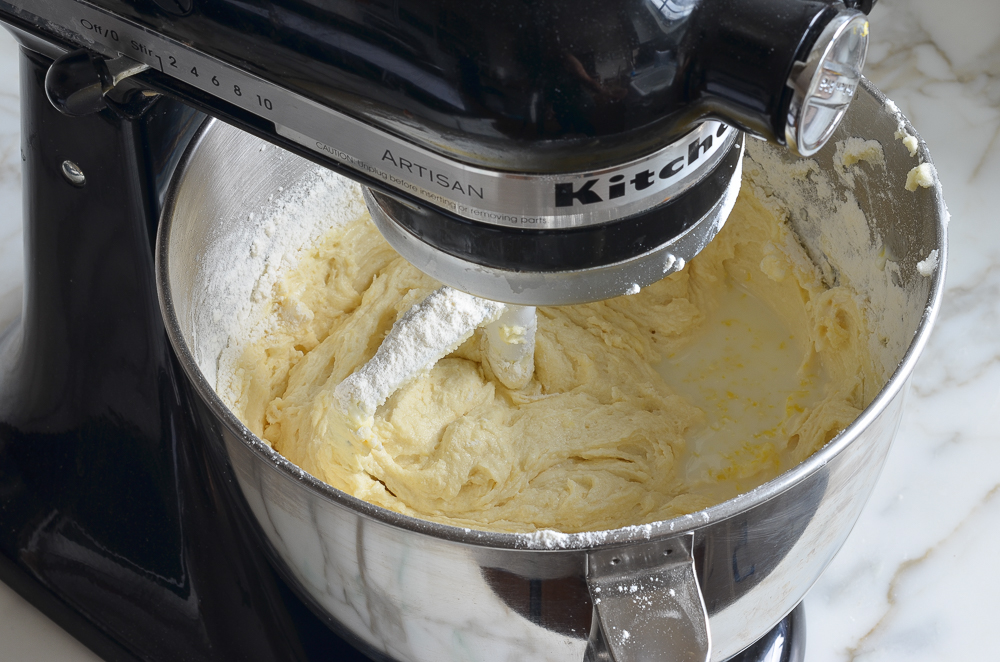
Scrape down the sides of the bowl, and give a quick mix to make sure all of the ingredients are well-incorporated.
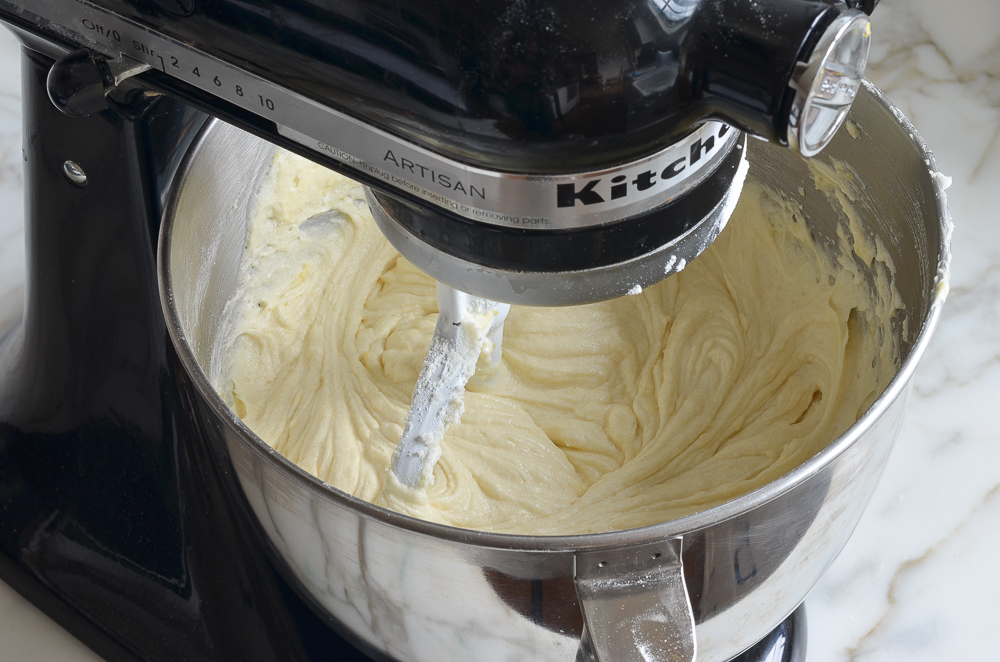
Transfer the cake batter to the prepared pans and smooth with a rubber spatula.
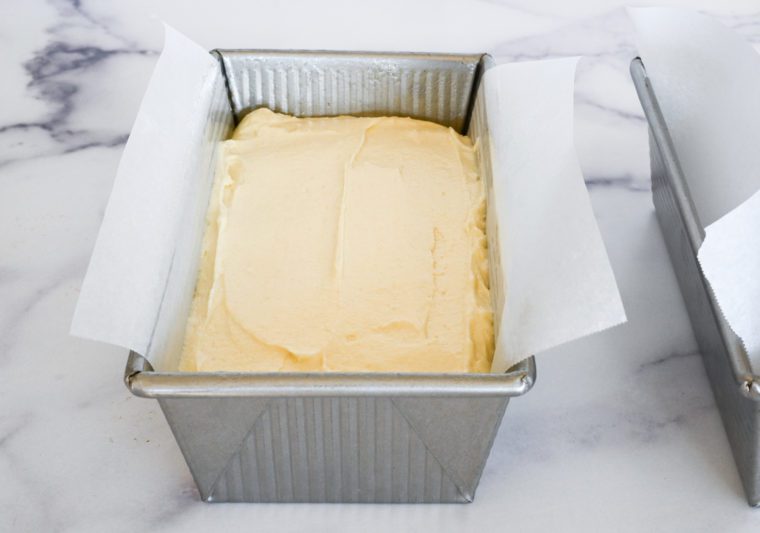
Bake for 55 to 65 minutes, or until the top is golden and a tester comes out clean.
Set the cakes on a cooling rack, and cool in the pans for 10 minutes.
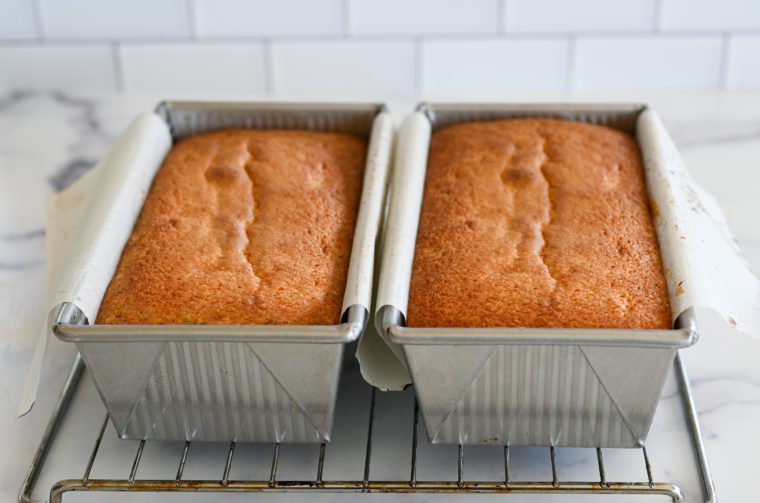
Carefully run a knife along the unlined sides of the pans to loosen the cake from the pan. Using the parchment slings, lift the cakes out of the pans and place onto the rack, leaving the parchment paper in place under the cakes. Let cool for about 1 hour.
When the cakes are almost cool, make the syrup. Combine the water and sugar in a saucepan and bring to a boil. Remove from the heat and stir in the lemon juice.
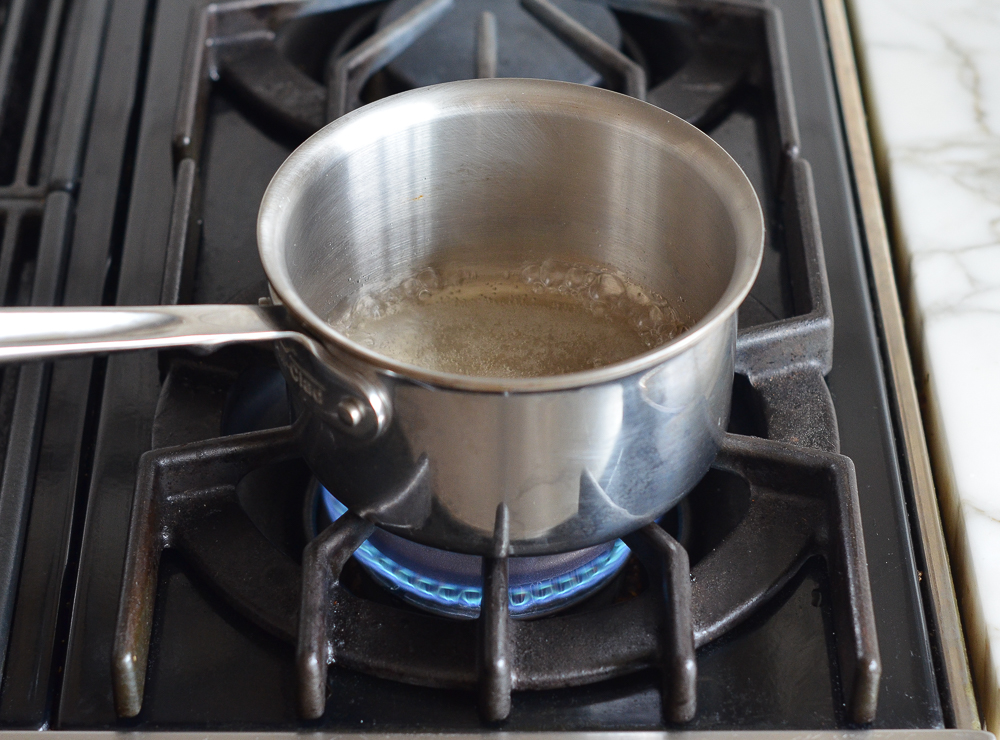
To make the glaze: in a medium bowl, whisk together the confectioners’ sugar and lemon juice. Add more confectioners’ sugar or lemon juice as necessary to make a thick but pourable glaze (it should be a little thicker than you’d think, about the consistency of molasses or honey).
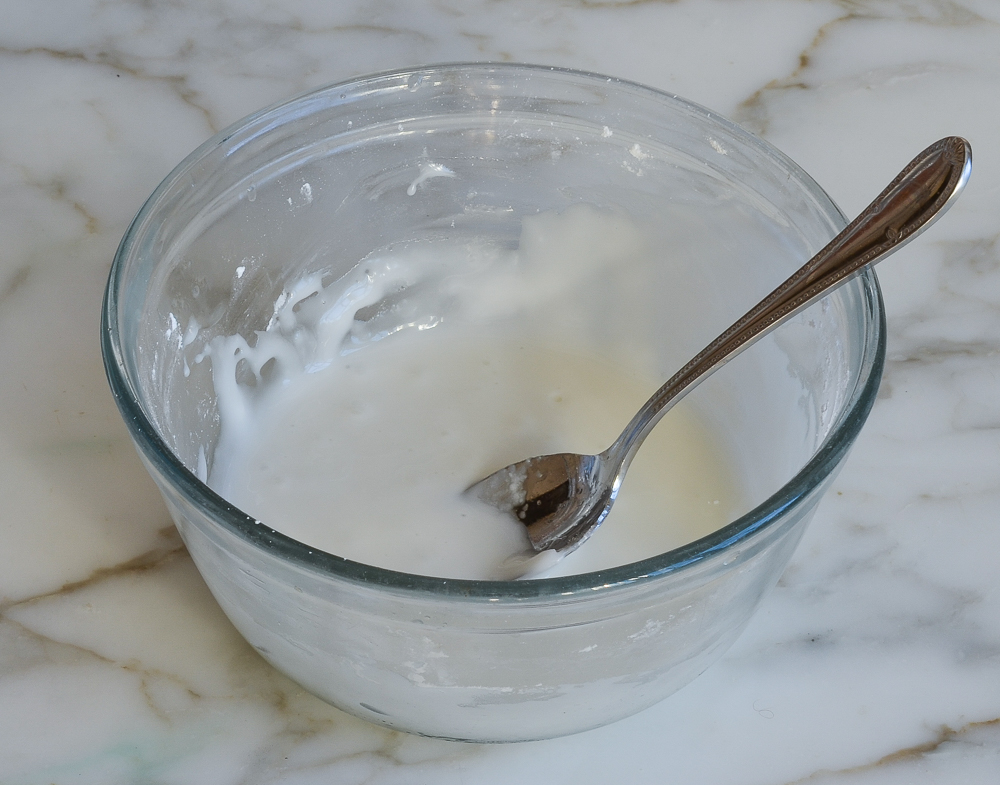
When the cakes are cool, carefully transfer them to serving platters. Gradually brush the warm syrup all over the cakes, including the sides, letting it soak in as you go.
Finally, spoon the glaze over the top of the cake, letting it drip down the sides.
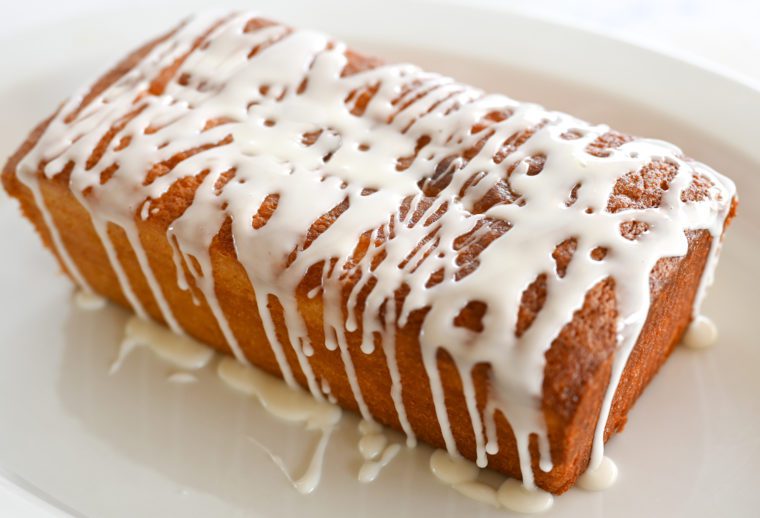
Let the cakes sit for about one hour to allow the glaze to set before serving.
How To Freeze Lemon Pound Cake
The cakes can be frozen without the glaze for up to 3 months. After they are completely cooled, double-wrap them securely with aluminum foil or plastic freezer wrap, or place them in a heavy-duty freezer bag. Thaw overnight on the countertop before serving. (Add the syrup before the cake is frozen and add the glaze after the cake is thawed.)
Note: This recipe was updated in 2022; to see the original version, click here.

You May Also Like
- Warm Lemon Pudding Cakes
- Lemon Poppy Seed Muffins
- Lemon Bars
- Cake Pans to Cookie Sheets: 16 Essential Baking Pans
Lemon Pound Cake
This lemon pound cake is the ultimate dessert for lemon lovers.
Ingredients
For the Cake
- 3 cups all-purpose flour, spooned into measuring cup and leveled-off with a knife
- ½ teaspoon baking soda
- ½ teaspoon salt
- 1 cup buttermilk (low-fat is fine) (see note)
- 2 tablespoons (packed) grated lemon zest (see note)
- 2 tablespoons fresh lemon juice
- 2 sticks (1 cup) unsalted butter, softened
- 2¼ cups granulated sugar
- 3 large eggs
For the Syrup
- 2 tablespoons water
- 2 tablespoons granulated sugar
- 2 teaspoons fresh lemon juice
For the Glaze
- 1 cup confectioners' sugar
- 2 tablespoons fresh lemon juice
Instructions
- Preheat the oven to 350°F and set an oven rack in the middle position. Spray two 8½ x 4½-inch loaf pans with nonstick cooking spray. Line the long sides of the pans with parchment paper “slings” and spray lightly with nonstick cooking spray again.
- In a medium bowl, whisk together the flour, baking soda and salt. Set aside.
- In another bowl, whisk together the buttermilk, lemon zest and lemon juice. Set aside.
- In the bowl of an electric mixer fitted with the paddle attachment (or beaters), cream the butter and sugar on medium speed until light and fluffy, 3 to 4 minutes. Scrape down the sides of the bowl, then beat in the eggs one at a time, beating well after each addition. Scrape down the sides of the bowl again.
- With the mixer on low speed, beat in one-quarter of the flour mixture, then one-third of the buttermilk mixture. Beat in another quarter of the flour, then another third of the buttermilk mixture. Repeat with another quarter of the flour and the remaining buttermilk mixture. Finally, beat in the remaining flour mixture. Scrape down the sides of the bowl, and give a quick mix to make sure all of the ingredients are well-incorporated.
- Divide the thick batter into the prepared pans and smooth with a rubber spatula. Bake for 55 to 65 minutes, or until the top is golden and a tester comes out clean.
- Set the cakes on a cooling rack, and cool in the pans for 10 minutes. Carefully run a knife along the unlined sides of the pans to loosen the cake from the pan. Using the parchment slings, lift the cakes out of the pans and place onto the rack, leaving the parchment paper in place under the cakes. Let cool for about 1 hour.
- When the cakes are almost cool, make the syrup. Combine the water and sugar in a saucepan and bring to a boil. Remove from the heat and stir in the lemon juice.
- When the cakes are cool, carefully transfer them to serving platters.
- Gradually brush the warm syrup all over the cakes, including the sides, letting it soak in as you go.
- To make the glaze: in a medium bowl, whisk together the confectioners' sugar and lemon juice. Add more confectioners' sugar or lemon juice as necessary to make a thick but pourable glaze (it should be a little thicker than you'd think, about the consistency of molasses or honey). Spoon the glaze over the top of the cake, letting it drip down the sides. Let the cakes sit for about one hour to allow the glaze to set before serving.
- Note: If you’d like to make your own buttermilk, check out the easy method here.
- Note: You'll need 4 to 5 large lemons for the entire recipe.
- Make-Ahead/Freezer-Friendly Instructions: The cakes can be made up to 1 day ahead of time and stored in a cake dome or airtight container at room temperature. They can also be frozen (without the final glaze) for up to 3 months. After they are completely cooled, double-wrap securely with aluminum foil or plastic freezer wrap, or place them in a heavy-duty freezer bag. Thaw overnight on the countertop before serving. (Add the syrup before the cake is frozen and add the glaze after the cake is thawed.)
Nutrition Information
Powered by ![]()
- Per serving (16 servings)
- Serving size: 1 slice
- Calories: 313
- Fat: 7g
- Saturated fat: 4g
- Carbohydrates: 59g
- Sugar: 40g
- Fiber: 1g
- Protein: 4g
- Sodium: 143mg
- Cholesterol: 51mg
This website is written and produced for informational purposes only. I am not a certified nutritionist and the nutritional data on this site has not been evaluated or approved by a nutritionist or the Food and Drug Administration. Nutritional information is offered as a courtesy and should not be construed as a guarantee. The data is calculated through an online nutritional calculator, Edamam.com. Although I do my best to provide accurate nutritional information, these figures should be considered estimates only. Varying factors such as product types or brands purchased, natural fluctuations in fresh produce, and the way ingredients are processed change the effective nutritional information in any given recipe. Furthermore, different online calculators provide different results depending on their own nutrition fact sources and algorithms. To obtain the most accurate nutritional information in a given recipe, you should calculate the nutritional information with the actual ingredients used in your recipe, using your preferred nutrition calculator.

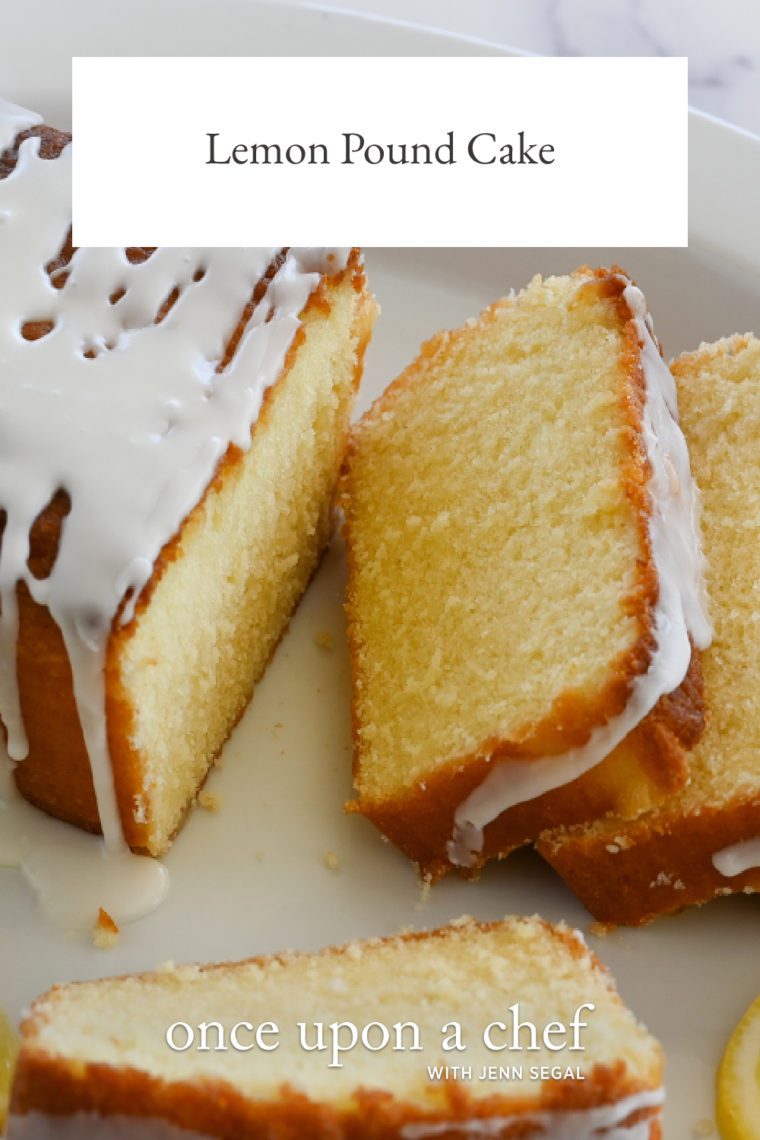
Hi Jenn,
Could you please let me know what is the weight of 1 cup of unsalted butter?
Hi Sally, It’s 230 grams. And the great majority of my recipes (including this one) include conversions to metric/weight measurements. To view them, scroll down to the recipe, and immediately under the recipe title on the right side, you’ll see a little toggle. If you move it from “cup measures” to metric, you’ll see measurements that will work for you. Hope that helps!
Thank you so much for sharing your recipe Jenn. It was superb. I made the Bundt version with 3/4 cup yoghurt & 1/4 cup milk. I also reduce sugar to 1 2/3 cups. I also use castor sugar. The cake was moist and delicious with a light hint of lemon!
So glad you enjoyed it — thanks for taking the time to report back! 🙂
First of all this pound cake is AMAZING!! Quick question. My oven has it done in 40 mins. The first batch was dry. Would reducing the heat to 325 (like your also AMAZING Pumpkin Bread) help? Thank you for so many wonderful recipes!
Hi Jessica, Are you using the soaking syrup at the end?
I am!!
The only other thing I can think of is that maybe you used too much flour. Did you use the spoon and level method? Even a few extra ounces can make a big difference. This article/video explains it nicely.
If you did use that method for measuring the flour, next time around I’d either reduce the oven temperature to 325° or bake it for less time.
I switched to the metric because I prefer weighing the ingredients. Unfortunately, the recipe didn’t turn out, very loose, spilled over pans, very chewy like it had too much sugar. When I checked the metric against your standard recipe, the metric sugar amount is off, it says 495 grams, but 2 1/4 cups of sugar should be 450 grams. I checked the rest, the flour is off but it’s actually a little over, (should be 360 grams). I think the biggest issue was the sugar.
Hi Kelly, I’m so sorry about the problem you had with the cakes! You’re right — the sugar was off by 45 grams and I think that’s what impacted your results (I’ve corrected it). Again, I’m sorry for the frustration!!
I made this exactly as instructed. I used Meyer lemons from my tree and it was delicious. A huge hit, everyone had seconds. I froze the second cake and will use it for Thanksgiving dessert.
Just a question. Can this recipe be made as one large cake? If so are you able to suggest cake pan size (say, 25cm) and cooking time? Much appreciated.
Hi Alison, I used to bake this recipe in a bundt pan. It looked beautiful but some people had problems with it sticking to the pan, so I revised it to be 2 loaves. Do you have a bundt? If so, you could go that route and treat the pan very well prior to baking. If you’d like to go that route, let me know and I’ll email you the recipe.
I have a question Jenn. This lemon pound cake is the BEST as are all your recipes. My question is about using Castor sugar. I’ve been seeing recipes using it (I actually made my own recently to use in a shortbread cookie recipe and they came out wonderful) but I was wondering if it would make a difference in cake recipes.
Hi Carol, So glad you like the recipes! 🙂
I’ve never baked with castor sugar but think that it’s doable. I’d suggest weighing the sugar though as castor sugar weighs 225 g per cup and granulated sugar weighs a little less, coming in at 220 g. Hope that helps!
I have not made this recipe yet but read all the reviews sounds delicious, my question is I would like to make this in mini loaf pans for giving, can it be done? If so how much per, how long and what temp would you recommend?
Hi Sue, I think mini loaves would work here. I’ve never made this in mini loaf pans, so I can’t say for sure, but I suspect it should make 4 – 5 loaves. The oven temp should be the same – I’m not certain how long they’ll take to bake (so keep a close eye on them), but I would start checking them at about 35 minutes. I’d love to hear how they turn out!
What if you’re trying to make it in a Bundt pan?
Hi Melissa, You can find the Bundt version here.
If making mini loaves (4-Inches x 2-Inches x 2-Inches), how many will this recipe make? Thanks!
Hi Aparna, I’ve never used loaf pans that size so I’m not sure, but I’d guesstimate 7 loaves or so. I’d love to hear how they turn out!
Hi Jenn,
Would like to ask if this recipe would work if I made it into small lemon shape breads but with lesser baking time?
Hi Rach, I have no reason to believe it wouldn’t work. Just make sure you treat your pans thoroughly with butter or cooking spray. Good luck!
Hi Jenn! It made six loaves. 🙂
Good to know — thanks for reporting back!
Do you mind sharing how long it took to bake them? I am trying this out right now 🙂
Jenn,
Thank you so much for sharing this recipe! I totally love it! The best lemon pound cake I ever had!
I had a little bit of leftover cake batter and I refrigerated it for 24 hours before I baked it into cupcakes and it turns out perfect too!!!!
Warning do not attempt this if you use the website’s convert to metric feature. the ratios are disastrously wrong! Trying again with cup measures 🤞
Best cake I’ve ever made, period. I was having guests and realized too late that I didn’t have enough lemon rind. I could only come up with half the amount of rind (I used lemon, orange and lime) but WOW did it ever turn out amazing! I just renamed it “citrus pound cake”. My guests took home the rest of the first cake and we ate the second one in two days (my husband called it “put on the pounds cake” because he couldn’t stop eating it.) The only problem I encountered was that I used one very intricate pound cake tin and some of the bottom stuck to the pan so I won’t be using that one again. The one that was made in the regular tin came out perfectly, even without the parchment sling. I buttered and floured both the pans. I’m making this cake for my introduction to the fancy neighbours this weekend because it is so perfect.